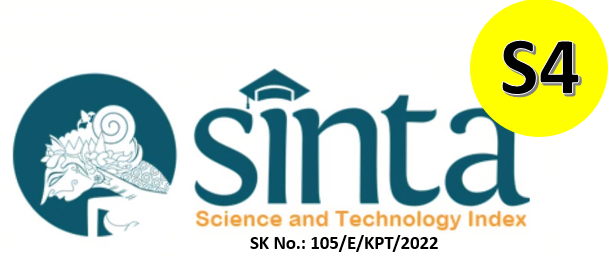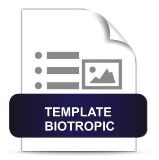Pengaruh Pemberian Bioherbisida Ekstrak Daun Ageratum conyzoides, Achasma walang, dan Wedelia trilobata terhadap Morfologi dan Stomata Daun Axonopus compressus
DOI:
https://doi.org/10.29080/biotropic.2022.1.1.38%20-%2044Keywords:
Achasma walang, Ageratum conyzoides, Axonopus compressus, bioherbicide, Wedelia trilobata, morphology, stomataAbstract
Axonopus compressus (Sw.) Beauv. is a type of weeds that grows invasively and wildly. The weeds growth can be controlled by applying bioherbicides. The leaf extracts of Wedelia trilobata, Achasma walang, and Ageratum conyzoides produce allelochemicals that can be used as bioherbicides. The study aims to determine the effects of applying bioherbicides from the leaf extracts of W. trilobata, A. walang, and A. conyzoides on the morphology and stomata of A. compressus weeds. This study was done by: 1) making the leaf extracts W. trilobata, A. walang, and A. conyzoides with each concentration is 10 ppm, 25 ppm, and 50 ppm; 2) giving the leaf extracts treatment on the growth of A. compressus weeds; and 3) making observations on the morphology and stomata of A. compressus weeds. The results showed that there were morphological transformations on the A. compressus weeds after applying the bioherbicides. The transformations were seen in the changing color of the leaves, the reduced leaf size, and the increased number of chlorotic leaves. Meanwhile, the effects of applying the bioherbicides on the stomata of A. compressus weeds were also found, i.e. in the changing size of stomata, and the increased of stomatal index and density.
Downloads
References
Atabayeva, S., Nurmahanova, A., Akhmetova, A., Namuratova, M., Asrandina, S., Beisenova, A., Aalbayeva, R. and T. Lee. 2016. Anatomical peculiarities in wheat (Triticum aestivum L.) varieties under copper stress. Pakistan Journal of Botany. 48(4): 1399-1405.
Bo, AB., Kim, JD., Kim, YS., Sin, HT., Kim, HJ., Khaitov, B., Ko, YK., Park, KW and JS. Choi. 2019. Isolation, identification and characterization of Streptomyces metabolites as a potential bioherbicide. PLoS ONE. 14(9): 1 - 18.
Dille, JA., Stahlman, PW., Thompson, CR., Bean, BW., Soltani, R. and P. Sikkema. 2020. Potential yield loss in grain sorghum (Sorghum bicolor) with weed interference in the United States. Weed Technology. 34(4): 624-629.
Gani, AA., Mukarlina and E. Rusmiyanto. 2017. Profil GC-MS dan potensi bioherbisida ekstrak methanol daun ketapang (Terminalia catappa L.) terhadap gulma maman ungu (Cleme rutidosperma D.C.). Protobiont. 6(2): 22-28.
Hamidah, HS., Mukarlina and R. Linda. 2015. Kemampuan ekstrak daun sembung rambat (Mikania micrantha H.B.K.) sebagai bioherbisida gulma Melastoma affine D.Don. Protobiont. 4(1): 89 - 93.
Hikmah, AU., Bilkis, FG., Maelani, DG. and Triastinurmiatiningsih. 2018. Pemanfaatan ekstrak daun babandotan (Ageratum conyzoides) sebagai bioherbisida gulma rumput teki (Cyperus rotundus). Ekologia. 18(1): 25 - 30.
Hussain, I., Singh, NB., Singh, S. and H. Singh. 2017. Allelopathic potential of sesame plant leachate against Cyperus rotundus L. Annals of Agrarian Science. 15(1): 141 - 147.
Ikbal, M., Damhuri and A. Munir. 2016. Jenis-jenis tumbuhan gulma di area persawahan desa Tajuncu kecamatan Mata Oleo kabupaten Bombana. Jurnal AMPIBI. 1(3): 10 - 14.
Le, VNT., Ahderom, S., Apopei, B. and K. Alameh. 2020. A novel method for detecting morphologically similar crops and weeds based on the combination of contour masks and filtered Local Binary Pattern operators. GigaScience. 9: 1 - 16.
Macías, FA., Mejías, FJR. and JMG. Molinilo. 2019. Recent advances in allelopathy for weed control: from knowledge to applications. Pest Management Science. 75(9): 2413 - 2436.
Nurjanah, U., Setyowati, N. and M. Simarmata. 2018. Allelopathic potential of aqueous extract of Archidendron jiringa (Jering) pods for weed control in the swamp paddy field. International Journal of Agricultural Technology. 16(5): 1153 - 1164.
Pebriani, Linda, R. and Mukarlina. 2013. Potensi ekstrak daun sembung rambat (Mikania micrantha H.B.K) sebagai bioherbisida terhadap gulma maman ungu (Cleome rutidosperma D.C.) dan rumput bahia (Paspalum notatum Flugge). Protobiont. 2(2): 32 - 38.
Raharja, RA., Hamim, H., Sulistyaningsih, YC. and T. Tridiati. 2020. Analisis morfosiologi, anatomi, dan histokimia pada lima spesies tanaman gulma sebagai respons terhadap merkuri dan timbal. Jurnal Ilmu Pertanian Indonesia (JIPI). 25(3): 412-423.
Richter, GL., Streck, NA., Zanon, AJ., Ulguim, AR., Kruse, ND., dos Santos, GAA., Cera, JC., Ribas, GG., Junior, AJD. and IB. Pilecco. 2019. Introducing rice yield loss caused by weed competition into the SimulArroz model. Pesquisa Agropecuária Brasileira. 54: 1 - 9.
Riskitavani, DV. and KI. Purwani. 2013. Studi potensi bioherbisida ekstrak daun ketapang (Terminalia catappa) terhadap gulma rumput teki (Cyperus rotundus). Jurnal Sains dan Seni POMITS. 2(2): 2337 - 3520.
Scavo, A., Pandino, G., Resstucia, A. and G. Mauromicale. 2020. Leaf extracts of cultivated cardoon as potential bioherbicide. Scientia Horticulturae. 261.
Setiani, D., Hastuti, ED. and S. Darmanti. 2019. Efek alelokimia ekstrak daun babandotan (Ageratum conyzoides L.) terhadap kandungan pigmen fotosintetik dan pertumbuhan gulma rumput belulang (Eleusine indica L. (Gaertn.)). Buletin Anatomi dan Fisiologi. 4(1): 1 - 7.
Silvia, RS., Igartuburu, JM., Overbeck, GE., Soares, GLG. and FA. Macías. 2020. Bioherbicide potential of Eucalyptus saligna leaf litter essential oil. Chemistry & Biodiversity. 17.
Downloads
Published
How to Cite
Issue
Section
License
Copyright (c) 2022 Riska Desi Aryani, Dian Palupi, Sri Lestari

This work is licensed under a Creative Commons Attribution-NonCommercial-ShareAlike 4.0 International License.













